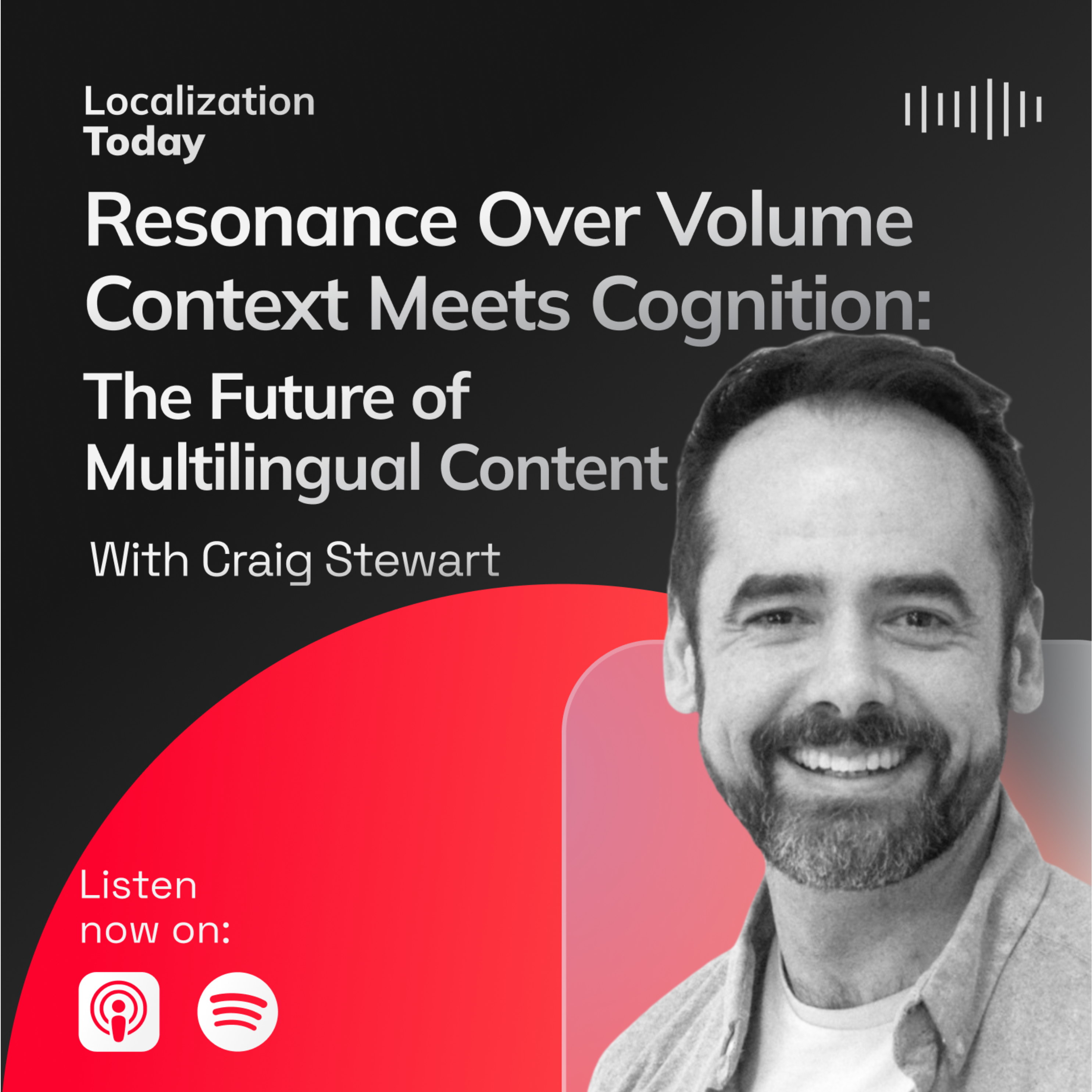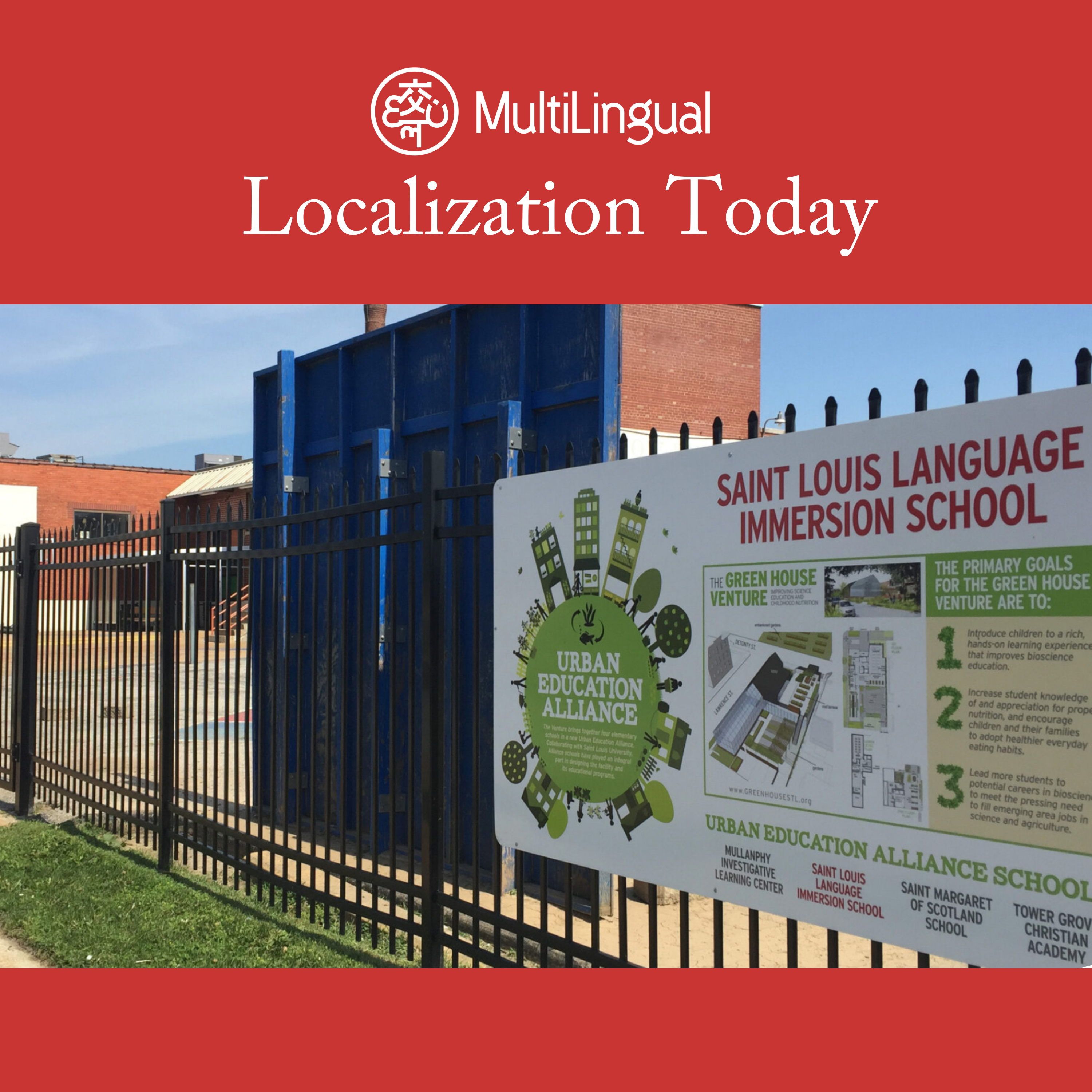Episode Transcript
[00:00:06] Speaker A: This is localization Today, a podcast from multilingual media covering the most relevant daily news in the language industry.
[00:00:15] Speaker B: ISO 5060 a translation quality management game Changer interview by Cameron Rasmussen in the modern world, peace of mind means everything.
[00:00:27] Speaker C: And nothing gives language service buyers peace of mind quite like knowing their language. Partners are among the most qualified in their field.
[00:00:35] Speaker B: Thats where professional standards come in.
[00:00:38] Speaker C: Its the simplest shorthand for demonstrating the.
[00:00:41] Speaker B: Mastery of complicated skills, best practices and concepts. Which raises the questions how are these standards developed? You decides what is important and what isnt.
[00:00:52] Speaker C: What is the process by which standards.
[00:00:54] Speaker B: Are developed and approved? Well, who better to answer those questions.
[00:00:59] Speaker C: Than two individuals who have done the work themselves?
Doctor Christopherkers and Alona Wahlberg contributed to multiple sets of standards for the International Organization for Standardization.
[00:01:12] Speaker B: Their latest effort is a new forthcoming set of standards, ISO 5060.
[00:01:19] Speaker C: Having worked in the translation industry since 2000, Kurz holds a degree in translation and a PH.
[00:01:25] Speaker B: D in quality management.
[00:01:27] Speaker C: His former roles include technical led translator.
[00:01:30] Speaker B: At SdL, now RWS, and translation project manager for Ferrari, BMW and Deutsch ban. Since 2016, he has been heading the.
[00:01:41] Speaker C: Translation management department at Enercon, a leading manufacturer of wind turbines. He is the project leader of ISO 5060 and has been a member of the ISO group of experts in TC 37, SC five double Ug one translation since 2011. He has also been involved in developing ISO 17,100, ISO 18,587 and ISO 11669. Ilona Wahlberg is managing director of Bioga Zelschaft first Prak and UN technology mbh and is responsible for quality management and human resources.
[00:02:21] Speaker B: Prior to that, she worked for Siemens for more than 22 years at the German Standards organization Deutschs Institute for Norming DIN.
[00:02:31] Speaker C: She heads the german mirror Committee for.
[00:02:33] Speaker B: Translation Interpretation and related technology.
[00:02:37] Speaker C: Since February 2023. She has chaired the advisory board of.
[00:02:42] Speaker B: DINS Terminology committee at ISOTC 37.
[00:02:46] Speaker C: She represents german interests in all subcommittees.
[00:02:49] Speaker B: As head of delegation.
Please tell us about these new standards. What sort of competencies are they intended to prove?
[00:02:57] Speaker D: The new and upcoming ISO 5060 evaluation of translation output aims to help translation buyers and translation service providers.
The goal is to provide a methodological.
[00:03:11] Speaker E: Framework for evaluating translation output professionally and objectively.
[00:03:16] Speaker D: Quite often we witness that translations are judged by personal preferences and in a highly subjective way. The new standard wants to level the.
[00:03:26] Speaker E: Playing field with regard to an objective.
[00:03:29] Speaker D: Unbiased, fair and analytic evaluation in order to get a clear and reliable picture.
[00:03:34] Speaker E: Of the translation quality.
One of the core values of ISO 5060 is that translation output can only be judged in relation to the translation requirements defined in the project specifications.
This links to ISO 17,100 and the revamped and upcoming ISO 11,669 translation projects.
[00:03:58] Speaker D: General guidance but regarding your question, ISO.
[00:04:01] Speaker E: 5060 is intended for the entire language.
[00:04:05] Speaker D: And translation industry for the output of human translation machine translation and post editing MT only projects and academia.
[00:04:16] Speaker B: What rationale led to these new standards being developed?
[00:04:20] Speaker C: What need in the market led to.
[00:04:21] Speaker B: The considerable effort in developing them?
[00:04:24] Speaker D: In recent years we witnessed that translations.
[00:04:28] Speaker E: Were evaluated according to SAEJ 2450 or.
[00:04:32] Speaker D: The Lisa QA model. Each of these models is useful and has its purpose and reasoning.
However, the common feedback from the translation.
[00:04:42] Speaker E: Industry was the lack of under demand for a universal translation quality evaluation standard that is neither overly complex nor so.
[00:04:50] Speaker D: Much stripped to the bone that it.
[00:04:52] Speaker E: Provides no methodological foundation and features, merely a basic scorecard.
[00:04:57] Speaker D: The feedback from the industry convinced us.
[00:05:00] Speaker E: That such a standard was missing and that it was something the professional translation.
[00:05:04] Speaker D: Industry was longing for, and that's the.
[00:05:07] Speaker E: Reason we started the project in early 2020.
[00:05:11] Speaker C: What is the current status of the.
[00:05:13] Speaker B: Development of these standards? When do you anticipate they'll be finished?
[00:05:18] Speaker F: The standard is now in the final draft.
[00:05:20] Speaker G: International standard stage the text has been.
[00:05:25] Speaker F: Finalized and sent to the ISO committee experts for review.
It is the last stage in which technical changes to the text can be.
[00:05:33] Speaker G: Made to a draft of a standard. After passing the FDIS stage and the corresponding ballot, it will take about two.
[00:05:40] Speaker F: To three months until the standard will be published.
So we are talking about mid 2024.
[00:05:47] Speaker B: Tell us a little about the development team who is working on this.
[00:05:52] Speaker F: The ISO committee TC 37 SC five Wg One translation developed the standard.
[00:05:59] Speaker G: At the moment, the membership features more.
[00:06:01] Speaker F: Than 30 countries from all over the.
[00:06:03] Speaker G: World and approximately half a dozen liaison.
[00:06:06] Speaker F: Members from the translation industry.
[00:06:09] Speaker G: The experts group comprises clients, TSP's, members of academia, supranational institutions and non governmental organizations NGO's.
So we can boldly claim that we.
[00:06:23] Speaker F: Listened to the ideas and received input from all stakeholders from the industry and that we took care of their needs.
[00:06:30] Speaker B: Can you tell us about the development process?
[00:06:33] Speaker F: The most important guideline for developing an.
[00:06:36] Speaker G: ISO standard is the ISO directives part two.
[00:06:40] Speaker F: It's an 80 page compendium that sets.
[00:06:42] Speaker G: Forth all rules, procedures and stages for developing an ISO standard. The time for developing an ISO standard is 36 months.
[00:06:52] Speaker F: In short, a project team comprising a project leader and an editor approaches the relevant ISO experts group with a new.
[00:06:59] Speaker G: Work item proposal, which is a document.
[00:07:02] Speaker F: Outlining the basic ideas for a new standard.
[00:07:05] Speaker G: It should feature a clear scope so.
[00:07:07] Speaker F: That everybody involved gets an idea of what the future standard might be about and to ensure everybody is on the same page.
[00:07:15] Speaker G: If the proposal is accepted, the draft.
[00:07:17] Speaker F: Is honed and fine tuned in different stages in which all countries involved in this ISO committee can comment on the draft and propose their ideas and changes.
This process is usually done during regular virtual meetings with the experts that each country nominates. A ballot takes place at certain stages and the standard requires a certain approval rate for it to continue to the next stage.
[00:07:42] Speaker G: Together with the vote, member countries are.
[00:07:45] Speaker F: Asked to hand in comments and suggestions.
[00:07:47] Speaker G: To improve the text.
[00:07:49] Speaker F: These comments are then discussed with the group of experts until the text reflects the ideas and reasoning of all experts actively involved in the process.
[00:07:58] Speaker G: So it's a very democratic and open.
[00:08:00] Speaker F: Procedure in which all experts can voice.
[00:08:03] Speaker G: Their opinions, ideas or doubts. On the other hand, this requires diplomatic.
[00:08:09] Speaker F: And sensitive handling of the discussions to.
[00:08:11] Speaker G: Keep everybody on board and get the.
[00:08:13] Speaker F: Full buy in from all the experts.
This is also why an ISO standard always reflects the expert's consensus.
[00:08:21] Speaker G: Consensus, however, does not require unanimity.
[00:08:25] Speaker C: Have the development of past standards influenced.
[00:08:27] Speaker B: The development of these new ones? How is this process similar and how is it different?
[00:08:33] Speaker D: In 2012 and 2019, two prior projects with a similar scope were cancelled.
[00:08:40] Speaker E: These two abandoned projects did indeed influence the development of ISO 5060.
Instead of going for the absolute maximum.
[00:08:49] Speaker D: We settled with the consent of the ISO experts for an approach of minimum complexity. We decided to opt for this route.
[00:08:57] Speaker E: To make the standard as broadly applicable as possible and not limit its window of applicability.
Other standards influencing this are ISO 17,100 and the extremely interesting, soon to be.
[00:09:10] Speaker D: Published ISO 116-0669 ISO 17,100 was most.
[00:09:18] Speaker E: Influential for ISO 5060 as it focuses on the definition of and adherence to translation requirements during the production of a translation.
This provided the yardstick for ISO 5060. If a requirement is stated in the translation brief or the translation specifications and.
[00:09:38] Speaker D: Is not complied with, this nonconformity has to be regarded as an error. If, on the other hand, something desired.
[00:09:46] Speaker E: By a translation requester or a client is not stated in the translation specifications.
[00:09:51] Speaker D: Its absence cannot be regarded as an error.
[00:09:54] Speaker E: So its basically all about translation specifications.
Each error is counted and assigned to.
[00:10:01] Speaker D: An error category depending on its severity.
[00:10:04] Speaker E: Different penalty points are assigned to an.
[00:10:06] Speaker D: Instance of an error, resulting in an.
[00:10:09] Speaker E: Error score and a subsequent quality rating for the evaluated translation.
[00:10:14] Speaker C: What sort of language companies should consider certifying in or adopting these new standards?
[00:10:20] Speaker F: Firstly, let me say that ISO 5060.
[00:10:24] Speaker G: Is not a requirement standard, but a guidance standard.
[00:10:28] Speaker F: It is therefore explicitly not intended for.
[00:10:31] Speaker G: Certification, but you can use it for your daily work and to help you.
[00:10:36] Speaker F: Set out a reliable framework.
[00:10:38] Speaker G: And of course you can state that you work according to this standard. The users of the standard can vary from large tsps to smaller tsps clients, institutions, freelancers, and academia.
[00:10:52] Speaker C: Are there other areas where the industry could benefit from additional standards? Given the technological transformation were all experiencing, it seems to me there will be no shortage of new skills to prove.
[00:11:04] Speaker B: In the years to come.
[00:11:06] Speaker G: Artificial intelligence, AI and large language models.
[00:11:11] Speaker F: Will be a new field of standardization.
There are so many things that should and could be standardized in that field that the development of standards will play an important part in the future.
[00:11:22] Speaker G: Regarding the current standards, the experts group.
[00:11:25] Speaker F: Will start on the overhaul of ISO 18587 post editing of machine translation.
[00:11:33] Speaker G: We recognized that this standard is outdated and that the use of MT and.
[00:11:37] Speaker F: The application of post editing has drastically changed since its publication in 2017.
[00:11:44] Speaker G: Therefore, the experts group will work on.
[00:11:47] Speaker F: This standard to mirror the current state of technology. There will also be a new standard for the development of source output that is intended for translation.
Here, internatiunel experts will guide the users through the jungle of phrases and signs that might cause misunderstandings or additional costs during translation or localization. ISO 18,968 translation oriented writing is the.
[00:12:12] Speaker G: Working title and it is due for.
[00:12:14] Speaker F: Publication in the summer of 2025.
[00:12:17] Speaker B: Do you have any particular hopes for.
[00:12:19] Speaker C: The future of standards and certification?
[00:12:22] Speaker D: In the wind energy sector and numerous other sectors, the application of standards is the norm. In some sectors the application of standards is even binding. We would be happy if the application.
[00:12:34] Speaker E: Of standards were to become more frequent.
[00:12:37] Speaker D: And more accepted in our industry too.
[00:12:39] Speaker E: We also hope our industrys sometimes negative view of standards will change over the.
[00:12:44] Speaker D: Years as we believe the negativity is undeserved. Standards are a means to provide guidance.
[00:12:50] Speaker E: And sometimes set requirements in order to.
[00:12:53] Speaker D: Achieve a common ground and a common understanding. But there is nothing compulsory about ISO.
[00:12:59] Speaker E: Standards in our industry.
[00:13:01] Speaker D: Its up to each TSP whether to work according to a standard.
[00:13:06] Speaker B: Is there anything else you want to add?
[00:13:09] Speaker G: As a project team, we hope that.
[00:13:11] Speaker F: ISO 5060 will be accepted and welcomed with open arms by the translation and language industry. We have all put endless hours of.
[00:13:19] Speaker G: Work into the standard and we are.
[00:13:22] Speaker F: Excited that it now has the look.
[00:13:23] Speaker G: And feel of a good standard.
[00:13:25] Speaker F: We are very grateful for every kind of feedback from the industry and hope that ISO 5060 will be well received.
[00:13:33] Speaker C: This article was written by Cameron Rasmussen, a senior writer and editor for multilingual.
[00:13:39] Speaker B: Media originally published in multilingual Magazine issue 226, March 20, 2024.
[00:13:49] Speaker A: Thank you for listening to localization today. To subscribe to multilingual magazine, go to multilingual.com subscribe.


